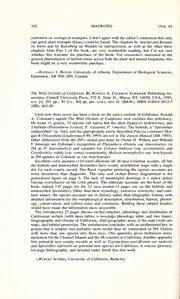
The Wild Orchids of California by Ronald A. Coleman PDF
Preview The Wild Orchids of California by Ronald A. Coleman
MADRONO 102 [Vol. 43 centrationon zoologicalexamples. Idon'tagreewiththeeditor's contentionthatonly one good plant example (Irises)could be found. The chaptersby Arnold andBennett on Irises and by Rieseberg an Wendel on introgression, as well as the other three chapters from Part 1 of the book, are very worthwhile reading, but I'm not sure whether this warrants the purchase of the book. For researchers interested in the general phenomenon ofhybrid zones across both the plant and animal kingdoms, this book might be a very worthwhile purchase. — Randall J. Bayer, University of Alberta, Department of Biological Sciences, Edmonton, AB T6E 2E9, Canada. The Wild Orchids ofCalifornia. By Ronald A. Coleman. Comstock Publishing As- sociates, Cornell University Press, 572 E. State St., Ithaca, NY 14850, USA, 1995, xvi, [i], 201 pp., 39 [i.e., 40] pp. pis. (col.), text ill. (B«feW), ISBN 0-8014-3012-7 (HB), $45.00. Until now there never has been a book on the native orchids ofCalifornia. Ronald A. Coleman's superb The Wild Orchids of California now rectifies this deficiency. He treats 11 genera, 33 species (all native but the alien Epipactis helleborine), and 3 hybrids(Platanthera Xestesii, P. Xlassenii, P. Xmedia).Thehybrids,a ''Spiranthes undescribed" (p. 166), andthe appropriatelynewly describedPiperia colemaniiMor- gan & Glicenstein(Lindleyana 8:89, 1993) are not in TheJepsonManual(JM; 1993). Other differences from the JM's orchid part done by Dieter H. Wilken and William F. Jennings are Coleman's recognition of Platanthera dilatata var. leucostachys (in JM as P. leucostachys) and varieties for Calypso bulbosa (var. occidentalis) and Corallorhiza trifida (var. verna) (consistently, Malaxis monophyllos ssp. brachypoda in JM appears in Coleman as var. brachypoda). Excellent color pictures (124 total) illustrate all 36 taxa Coleman accepts; all but the hybrids and undescribed Spiranthes have county distribution maps with a single dot for each county record. The floral vignettes prefacing the species accounts are more decorative than diagnostic. The only real orchid flower diagrammed is the generalized figure on page 5. The lack of meaningful drawings is a minor defect forcing overreliance on the color photos. The elaborate accounts are the heart ofthe book, indeed 135 pages for the 32 taxa treated (3 pages are on the hybrids and undescribed Spiranthes). Other than their etymology, extensive synonymy, and com- mon names, the species accounts are in literary rather than telegraphic format, with detailed information for the morphological description, distribution, habitat, phenol- ogy, conservation, and (often) notes and comments. Bolding these subject headers would have made the information more accessible. The introductory 27 pages discuss orchid structure, phenology and distribution of Californian orchids (with three tables, a two-page phenology table, and two maps), biogeography and climate ofCalifornia, chiefgeographic areas ofthe state (with one map), and habitat protection. The introduction concludes with an unillustrated key to genera that is simpler and probably more useful than its counterpart in JM. Genera with more than one species also have keys. One appendix gives herbarium docu- mentationfortheChannelIslandsandthe58 countiesinCalifornia.Anotherappendix lists potential new county records as well as Cypripedium parviflorum var. makasin and Spiranthes infernalis as potential new species forCalifornia. A concise glossary, ten-page bibliography, and detailed index finish this fine work. — Rudolf Schmid, University ofCalifornia, Berkeley.
